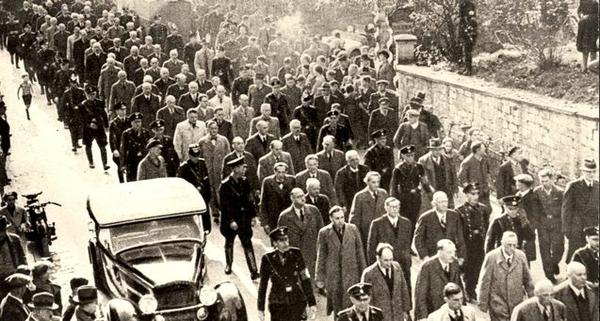June 21, 2024 Hello , Happy Friday! Busy here this week, so today's feature story is from the archives about a woman they called the Sausage King's Daughter. It's one of my favorites! Ottilie Gobel Moore grew up in New York City, famous in the society pages as the daughter of the rags to riches "Sausage King" of Brooklyn. The New York Post called her a pleasant, attractive and capable widow. Others called her eccentric, impulsive, and forceful. She must have been all that, plus resourceful and generous.
A One-Woman Refugee Association
In 1941, as the Nazi Regime expanded its power and rounded up Jews for extermination, Ottilie drove the eight kids in a station wagon over one-thousand miles to safety. From the south of France, they traveled through Spain across Portugal to the port city of Lisbon, where they caught a boat to America. Here they are on the arriving in New York.
Ottilie Moore (on steps, left) Shown are 13- and 12-year-old
Robert and Henry Durand; 13- and 11-year-old Dora and Betty Steuer; Max Beeckmann, 15, Roger Kaufer, 1; Hermann Spitz, 2; Valerie Page, 9; Moore's daughter, also Ottilie 13; nephew Wallace Moore, 12 and poodle, Martini.
In 1936, Dora and Betty Steuer were six and eight when Nazi soldiers
marched into the Rhineland, launching German aggression in Western Europe and spreading hatred of Jews. The girls' father was sent to Dachau, their mother, who was
expecting another child was sent to an institution and they were sent away for safety, cared for first in Holland, then Belgium and finally to France. In 1938, when
Hitler annexed Austria, Roger Kaufer's father was sent to a concentration camp, then his mother committed suicide. Friends helped Roger escape to France.
Jewish men rounded up for deportation to Dachau, Baden Baden, Germany, 1938. The stream of Jewish refugees soon became apparent to Ottilie Gobel Moore who’d moved to L’Ermitage, a villa on the French Riviera in 1929. L’Ermitage was a lovely estate with several houses, terraced gardens, fruit trees, and small waterfalls overlooking the bay of Villefranche-sur-mer near Nice. Seven-year-old Valerie Page was the first child to take refuge there. Ottilie offered to care for Valerie while her mother returned to England to join the British women's naval corps.
Ottilie Gobel Moore
“I began taking in refugees when the war started," Ottilie said, "the kind of people that the relief organizations were
not prepared to are for. "Dora and Betty Steuer, for example, were to have been sent to Canada, but a hitch developed,
and they were sent to my villa. At one time I had as many as 27 refugees living there and I was feeding as many as 40.” When Germany invaded France in 1940, food
became scarce, and Ottilie grew more and more worried about the safety of the children in her care. Thousands of Jews had requested visas from authorities in Nice, and were turned away with the stamp “Case Killed.”
Ottilie Moore (center) with Valerie Page (sitting, third from right) and the other children she
rescued. But Ottilie displayed her forcefulness, plus perseverance, procuring visas for six children. She hurdled the next problem, scarce
gasoline, by trading a pig and five chickens to a neighbor for fuel, then loaded the six kids along with her own daughter and nephew into her luxury station wagon on September 22, 1941, and made a run for it. The trip across Spain and Portugal took ten days. The older children crowded together in the front and back seats, with two babies lying in cradles hung from the car ceiling, and they towed a huge load of suitcases on a trailer behind. And there is one report that a goat came along on the trip to be traded for gasoline along the way. One of the first nights they stopped in Béziers, France, but were turned away by the hotel keeper until word carried to town leaders who shamed him into taking them in. The continued into Spain until their car broke down and they became stranded for three days in a cork grove until a
Spanish policeman arrived and helped fix the car. Arriving in Lisbon, the boarded the ship Excalibur and set sail for New York, but their troubles weren't over. The
first day out to sea, a Nazi bomber circled overhead. Turns out it was a spotter, and shortly thereafter the Nazis torpedoed and sank two other ships close by. The
group arrived safely in New York city October 10, 1941.
Ottilie had grown up the eldest daughter of a German immigrant named Adolf Gobel, who began selling sausages door to door in a straw basket in 1904, and twenty years later ran the largest independent sausage and meat manufacturer in the country. His sausages had a reputation for full flavor and fine quality. And demand grew for meat products as the sandwich, the fast food of the day, grew in popularity as an easy and affordable lunch for a city on the go. Adolf Gobel had died in 1924, leaving his $3 million dollar company to his wife and children, the sale of which allowed Ottilie to travel abroad and live in France, where she was ready to help when WWII broke out.
Like my article today? Please share:
Follow me on social media
This newsletter is a reader-supported publication. To support my work, consider becoming a paid subscriber.
Read
a great book? Have a burning question? Let me know. If you know someone who might enjoy my newsletter or books, please forward this e-mail. I will never spam you or sell your email address, you can unsubscribe anytime at the link below. To find out more about my books, how I help students, teachers, librarians and writers visit my website at www.MaryCronkFarrell.com. Contact me at MaryCronkFarrell@gmail.com. Click here to subscribe to this newsletter. |
|
|







